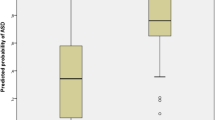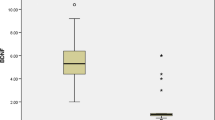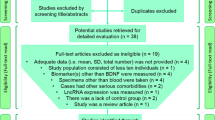Abstract
The aim of our study was to illuminate the potential role of brain-derived neurotrophic factor (BDNF) in autism spectrum disorder (ASD). We measured the circulating levels of BDNF in serum and BDNF gene (Val66Met) polymorphisms, in which two indicators were then compared between ASD and normal controls. A total of 82 drug-naïve ASD children and 82 age- and gender-matched normal controls were enrolled in the study. Their serum BDNF levels were detected by the ELISA. BDNF Val66Met polymorphism genotyping was conducted as according to the laboratory’s standard protocol in laboratory. The ASD severity assessment was mainly determined by the score of the Childhood Autism Rating Scale (CARS). ELISA assay showed that the mean serum BDNF level of children with ASD was significantly (P < 0.0001) higher than that of the control cases (17.75 ± 5.43 vs. 11.49 ± 2.85 ng/ml; t = 9.236). Besides, the serum BDNF levels and CARS scores (P < 0.0001) were positively related. And, the BDNF genotyping results showed that there was no difference between the ASD cases and the control. Among the children with ASD, the mean serum BDNF level of Met/Met group was lower than other groups. According to the ROC curve generated from our clinical data, the optimal cutoff value of serum BDNF levels, an indicator for diagnosis of ASD, was projected to be 12.50 ng/ml. Thus, it yielded a corresponding sensitivity of 81.7 % and the specificity of 66.9 %. Accordingly, area value under the curve was 0.836 (95 % CI, 0.774–0.897); the positive predictive value (PPV) and the negative predictive value (NPV) were 70.1 and 79.1 %, respectively. These results suggested that rather than Val66Met polymorphism, BDNF was more possible to impact the pathogenesis of ASD.



Similar content being viewed by others
References
Yoo HJ, Yang SY, Cho IH et al (2014) Polymorphisms of BDNF gene and autism spectrum disorders: family based association study with Korean trios. Psychiatry Invest 11(3):319–324
Wong VCN, Hui SLH (2008) Epidemiological study of autism spectrum disorder in China. J Child Neurol 23:67–72
Tu WJ, Yin CH, Guo YQ, Li SO, Chen H, Zhang Y, Feng YL, Long BH (2013) Serum homocysteine concentrations in Chinese children with autism. Clin Chem Lab Med 51:e19–e22
Al-Ayadhi LY (2012) Relationship between Sonic hedgehog protein, brain-derived neurotrophic factor and oxidative stress in autism spectrum disorders. Neurochem Res 37(2):394–400
Halepoto DM, Bashir S, AL-Ayadhi L (2014) Possible role of brain-derived neurotrophic factor (BDNF) in autism spectrum disorder: current status. J College Physicians Surgeons Pakistan 24(4):274–278
Yan CL, Zhang J, Hou Y (2015) Decreased plasma levels of lipoxin A4 in children with autism spectrum disorders. NeuroReport 26:341–345
Taurines R, Segura M, Schecklmann M et al (2014) Altered peripheral BDNF mRNA expression and BDNF protein concentrations in blood of children and adolescents with autism spectrum disorder. J Neural Transm 121(9):1117–1128
Nelson PG, Kuddo T, Song EY et al (2006) Selected neurotrophins, neuropeptides, and cytokines: developmental trajectory and concentrations in neonatal blood of children with autism or Down syndrome. Int J Dev Neurosci 24(1):73–80
Nishimura K, Nakamura K, Anitha A et al (2007) Genetic analyses of the brain-derived neurotrophic factor (BDNF) gene in autism. Biochem Biophys Res Commun 356(1):200–206
AL-Ayadhi L (2011) Serum levels of brain-derived neurotrophic factor (BDNF) in autistic children in central Saudi Arabia. Open Conference Proc J 2(1):36–40
Ricci S, Businaro R, Ippoliti F et al (2013) Altered cytokine and BDNF levels in autism spectrum disorder. Neurotox Res 24(4):491–501
Bryn V, Halvorsen B, Ueland T et al (2015) Brain derived neurotrophic factor (BDNF) and autism spectrum disorders (ASD) in childhood. Eur J Paediatr Neurol 19:411–414
Notaras M, Hill R, Van den Buuse M (2015) A role for the BDNF gene Val66Met polymorphism in schizophrenia? A comprehensive review. Neurosci Biobehav Rev 51:15–30
Gadow KD, Roohi J, DeVincent CJ, Kirsch S, Hatchwell E (2009) Association of COMT(Val158Met) and BDNF (Val66Met) gene polymorphisms with anxiety, ADHD and tics in children with autism spectrum disorder. J Autism Dev Disord 39:1542–1551
Hwang JP, Tsai SJ, Hong CJ et al (2006) The Val66Met polymorphism of the brain-derived neurotrophic-factor gene is associated with geriatric depression. Neurobiol Aging 27(12):1834–1837
Raznahan A, Toro R, Proitsi P, Powell J, Paus TF, Bolton P et al (2009) A functional polymorphism of the brain derived neurotrophic factor gene and cortical anatomy in autism spectrum disorder. J Neurodev Disord 1:215–223
Schopler E, Reichler RJ, DeVellis RF, Daly K (1980) Toward objective classification of childhood autism: childhood autism rating scale (CARS). J Autism Dev Disord 10:91–103
Park MH, Chang KD, Hallmayer J et al (2015) Preliminary study of anxiety symptoms, family dysfunction, and the brain-derived neurotrophic factor (BDNF) Val66Met genotype in offspring of parents with bipolar disorder. J Psychiatr Res 61:81–88
Fiala JC, Spacek J, Harris KM (2002) Dendritic spine pathology: cause or consequence of neurological disorders? Brain Res Brain Res Rev 39:29–54
Tyler WJ, Zhang XL, Hartman K, Winterer J, Muller W, Stanton PK et al (2006) BDNF increases release probability and the size of a rapidly recycling vesicle pool within rat hippocampal excitatory synapses. J Physiol 574:787–803
Mansour M, Mohamed A, Azam H, Henedy M (2010) Brain derived neurotrophic factor in autism. Current Psychiatry 17(1):23–29
Hashimoto K, Iwata Y, Nakamura K et al (2006) Reduced serum levels of brain-derived neurotrophic factor in adult male patients with autism. Prog Neuro-Psychopharmacol Biol Psychiatry 30(8):1529–1531
Zhang Q, Jiang L, Lu YJ (2014) Serum brain-derived neurotrophic factor levels in Chinese children with autism spectrum disorders: A pilot study. Int J Dev Neurosci 37:65–68
Cheng L, Ge Q, Sun B, Yu P, Ke X, Lu Z (2009) Polyacrylamide gel-based microarray: a novel method applied to the association Study between the polymorphisms of BDNF gene and autism. J Biomed Nanotechnol 5:542–550
Egan MF, Kojima M, Callicott JH et al (2003) The BDNF val66met polymorphism affects activity-dependent secretion of BDNF and human memory and hippocampal function. Cell 112(2):257–269
Hariri AR, Goldberg TE, Mattay VS et al (2003) Brain-derived neurotrophic factor val66met polymorphism affects human memory-related hippocampal activity and predicts memory performance. J Neuroscience 23(17):6690–6694
Frodl T, Schüle C, Schmitt G et al (2007) Association of the brain-derived neurotrophic factor Val66Met polymorphism with reduced hippocampal volumes in major depression. Arch Gen Psychiatry 64(4):410–416
Chen ZY, JingD BKG, Ieraci A, KhanT SCJ et al (2006) Genetic variantBDNF (Val66Met) polymorphism alters anxiety-related behavior. Science 314:140–143
Bus BAA, Arias-Vasquez A, Franke B et al (2012) Increase in serum brain-derived neurotrophic factor in met allele carriers of the BDNF Val66Met polymorphism is specific to males. Neuropsychobiology 65(4):183–187
Lang UE, Hellweg R, Sander T et al (2009) The Met allele of the BDNF Val66Met polymorphism is associated with increased BDNF serum concentrations. Mol Psychiatry 14(2):120–122
Bashir S, Laila ALA (2013) Role of serum levels of neurotensin in children with autism spectrum disorder. Neurol Psychiatry Brain Res 19(2):59–63
Li B, Lang N, Cheng ZF (2015) Serum Levels of Brain-Derived Neurotrophic Factor Are Associated with Diabetes Risk, Complications, and Obesity: a Cohort Study from Chinese Patients with Type 2 Diabetes. Mol Neurobiol. doi:10.1007/s12035-015-9461-2
Agilli M, Aydin FN, Kurt YG et al (2015) Evaluation of serum brain-derived neurotrophic factor levels in type 2 diabetes mellitus patients with and without depressive symptoms. Acta Biochim Biophys Sin 47(4):313
Klein AB, Williamson R, Santini MA et al (2011) Blood BDNF concentrations reflect brain-tissue BDNF levels across species. Int J Neuropsychopharmacol 14(3):347–353
Shi SS, Shao S, Yuan B et al (2010) Acute stress and chronic stress change brain-derived neurotrophic factor (BDNF) and tyrosine kinase-coupled receptor (TrkB) expression in both young and aged rat hippocampus. Yonsei Med J 51(5):661–671
Katoh-Semba R, Wakako R, Komori T et al (2007) Age-related changes in BDNF protein levels in human serum: differences between autism cases and normal controls. Int J Dev Neurosci 25(6):367–372
Acknowledgments
We are grateful to the children, nurses, and physicians who participated in our study. Authors also acknowledge the contribution of the reviewers who have helped us to improve the manuscript.
Author information
Authors and Affiliations
Corresponding authors
Ethics declarations
Conflicts of Interest
On behalf of all authors, the corresponding author states that there is no conflict of interest.
Research Involving Human Participants
This study was approved by the institutional review board of the Liaocheng People’s Hospital.
Informed Consent
Informed written consent was obtained from each patient, family, or legal guardian.
Rights and permissions
About this article
Cite this article
Meng, WD., Sun, SJ., Yang, J. et al. Elevated Serum Brain-Derived Neurotrophic Factor (BDNF) but not BDNF Gene Val66Met Polymorphism Is Associated with Autism Spectrum Disorders. Mol Neurobiol 54, 1167–1172 (2017). https://doi.org/10.1007/s12035-016-9721-9
Received:
Accepted:
Published:
Issue Date:
DOI: https://doi.org/10.1007/s12035-016-9721-9




